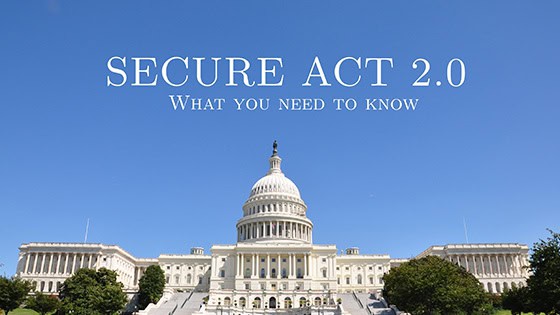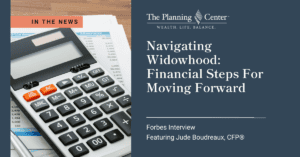
By Aristotle Makris, CPA, CFP®
Congress first passed the Secure Act in 2019 in an effort to improve retirement-savings opportunities for Americans. At the end of 2022, Congress updated the legislation to address additional issues that weren’t part of the original law. The Secure Act 2.0 contains no less than 92 new provisions which are intended to promote savings, boost incentives for businesses, and offer more flexibility to individuals saving for retirement.
One of the most talked about provisions involves the increased age at which individuals need to begin taking required minimum distributions (RMD), a topic I covered previously. We’ll look at a few of the other major changes here.
Secure Act 2.0 – Catch-Up Provision
For anyone who’s 50 or older, the new rules boost catch-up contributions, allowing you to put more money into your retirement savings accounts than what is normally allowed for the year. If you’re behind on your retirement savings, this is a chance to “catch up.” The Secure Act 2.0 phases in different provisions over the next few years.
In 2023: If you have a 401(k), 403(b), or other qualified retirement plan, the catch-up amount increased to an additional $7,500 on top of the $22,500 annual federal limit in 2023.
In 2024: For high wage earners, defined as making over $145K annually, catch-up contributions can no longer be made with pre-tax dollars. If you currently have a 401(k), or other retirement plan where you’re making pre-tax contributions, you will only be able to make the catch-up contribution to the Roth portion of your 401(k) plan. (See below for more about Roth accounts.) Also, beginning in 2024, catch-up contributions to IRAs will be adjusted for inflation in increments of $100.
In 2025: For those aged 60-63, you’ll have even more ability to boost your catch-up contributions to your 401(k), or other similar plans. Starting in 2025, you’ll be allowed to contribute whichever of the following amounts is greater: $10,000 or 150% more than the applicable catch-up limit from the previous year.
Secure Act 2.0 Increases Roth Options
Starting in 2024, employers must have a Roth option in order for employees to make catch-up contributions. To facilitate that change, the Secure Act 2.0 allows for small business owners to open and contribute to Roth SEP IRAs and Roth SIMPLE IRAs, which creates some parity between large and small employer plan options. If your employer doesn’t currently have a Roth option, talk to your 401K administrator. This provision doesn’t kick in until 2024 so you have some time, but your administrator will need a few months to make the necessary adjustments. Employers generally want to complete any updates to their retirement plans by October for open enrollment.
While we’re on the topic, the new Secure Act does not make any changes to Roth IRAs and still allows individuals to convert funds from a traditional IRA to a Roth IRA using the back-door approach.
Unspent 529 Plans Can Be Contributed to Roth IRAs
This provision seems like it would be great, but it contains a lot of qualifiers such that in the end, it’s not as great as it sounds. Simply put, if you have unused funds in a 529 College Savings Plan, that money can now be rolled over into a Roth IRA with the following stipulations:
- The 529 Plan has to have been established for 15 years.
- Any contributions you made to the plan for the prior 5 years won’t qualify for the rollover.
- You are limited to the typical Roth contribution of $6,000 per year.
- The aggregate lifetime contribution limit is $35,000.
Given the annual contribution limit, it would take 5-6 years to contribute the maximum allowed. Still, if you have funds remaining in 529 accounts set up for your children or grandchildren, this provision allows you to assist them with their own retirement and income tax planning. Just expect to jump through a few hoops.
To find out how changes to the Secure Act could affect you, contact The Planning Center. As dedicated fiduciaries we’ll help you navigate changes in tax laws so you can take advantage of opportunities to save more for retirement.





